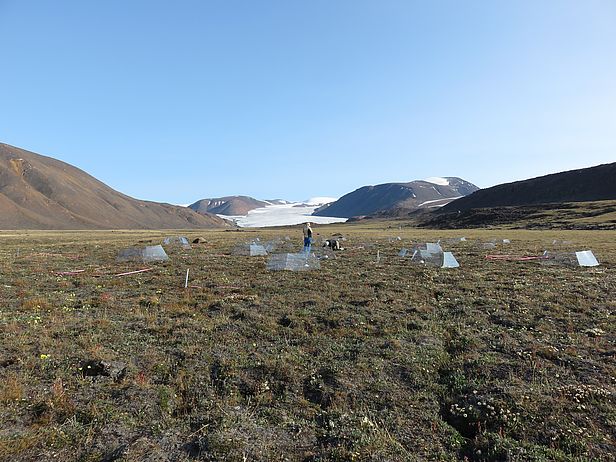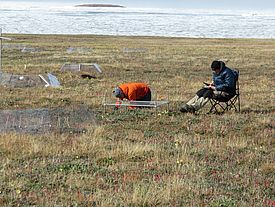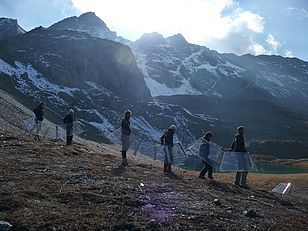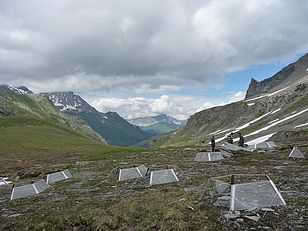For 30 years, an international experiment has been documenting how tundra vegetation is changing as a result of climate change, at locations including the SLF-managed Val Bercla site. The latest results are summarised in a recent special issue of Arctic Science.
The word 'tundra' conjures up images of treeless expanses in Scandinavia, Canada or Russia, characterised by lichens, mosses, grasses and dwarf shrubs. However, similar types of vegetation can also be found above the treeline in the Alps and other mountain ranges, which are often home to the same plant species as their Arctic counterpart or to related species.
Taller plants and more shrubs ¶
Both Arctic and alpine tundra vegetation is changing rapidly and dramatically in response to climate change. As a result of the rise in temperatures, plants are tending to grow taller and flower earlier, especially in the case of late-flowering species. This shortens the flowering season in the tundra as a whole, which in turn could have an impact on pollinating insects. However, the composition of plant species there is also changing. Thus, in many locations dwarf shrubs have spread to the detriment of mosses and lichens. As a result, the reflectivity (albedo) of the ground surface decreases – more sunlight is absorbed, leading to even greater local warming.
Unique data collection thanks to 30-year experiment ¶
The results of the research were recently published in a special issue of the journal Arctic Science. They come from the International Tundra Experiment (ITEX) – a vegetation monitoring study that was launched in alpine and Arctic tundra ecosystems in the early 1990s. Research teams at more than 40 study sites worldwide are now documenting how cold-adapted plant communities are changing because of ever warmer summers. Among these locations is the remote Val Bercla site near Bivio in the canton of Grisons in Switzerland, where since 1994, Swiss Federal Institute for Forest, Snow and Landscape Research (WSL) employees from Davos and Birmensdorf have been monitoring how the alpine tundra has been responding to climate change. As at most other sites, they are also conducting experiments using passive warming chambers – small, roofless greenhouses where solar radiation increases the air temperature. In this way, researchers are simulating how vegetation will develop in the event of even greater climate warming in the future.
Thanks to these global investigations, a unique data collection has been created over the years, enabling both temporal and spatial comparisons of tundra vegetation. Some of the results are now summarised in the special issue of Arctic Science, paying tribute to 30 years of research and monitoring of Arctic and alpine tundra ecosystems.
Contact ¶
Links and documents ¶
Publications ¶
Henry G.H.R., Hollister R.D., Klanderud K., Björk R.G., Bjorkman A.D., Elphinstone C., … Wookey P.A. (2022) The International Tundra Experiment (ITEX): 30 years of research on tundra ecosystems. Arct. Sci. 8(3), 550-571. https://doi.org/10.1139/as-2022-0041 Institutional Repository DORA
Rixen C., Høye T.T., Macek P., Aerts R., Alatalo J., Andeson J.T., … Zong S. (2022) Winters are changing: snow effects on Arctic and alpine tundra ecosystems. Arct. Sci. 8(3), 572-608. https://doi.org/10.1139/AS-2020-0058 Institutional Repository DORA
Frei E.R., Henry G.H.R. (2021) Long-term effects of snowmelt timing and climate warming on phenology, growth and reproductive effort of arctic tundra plant species. Arct. Sci. 8(3), 700-721. https://doi.org/10.1139/AS-2021-0028 Institutional Repository DORA
Prevéy J.S., Elmendorf S.C., Bjorkman A., Alatalo J.M., Ashton I., Assmann J.J., … Yang Y. (2022) The tundra phenology database: more than two decades of tundra phenology responses to climate change. Arct. Sci. 8(3), 1026-1039. https://doi.org/10.1139/as-2020-0041 Institutional Repository DORA
Panchen Z.A., Frei E.R., Henry G.H.R. (2022) Increased Arctic climate extremes constrain expected higher plant reproductive success in a warmer climate. Arct. Sci. 8(3), 680-689. https://doi.org/10.1139/AS-2020-0045 Institutional Repository DORA
Lett S., Jónsdóttir I.S., Becker-Scarpitta A., Christiansen C.T., During H., Ekelund F., … van Zuijlen K. (2022) Can bryophyte groups increase functional resolution in tundra ecosystems? Arct. Sci. 8, 609-637. https://doi.org/10.1139/as-2020-0057 Institutional Repository DORA
Copyright ¶
WSL and SLF provide the artwork for imaging of press articles relating to this media release for free. Transferring and saving the images in image databases and saving of images by third parties is not allowed.






